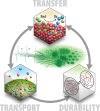Soft Materials for Photoelectrochemical Fuel Production
- PMID: 38094752
- PMCID: PMC10714404
- DOI: 10.1021/acsenergylett.3c01782
Soft Materials for Photoelectrochemical Fuel Production
Abstract
Polymer semiconductors are fascinating materials that could enable delivery of chemical fuels from water and sunlight, offering several potential advantages over their inorganic counterparts. These include extensive synthetic tunability of optoelectronic and redox properties and unique opportunities to tailor catalytic sites via chemical control over the nanoenvironment. Added to this is proven functionality of polymer semiconductors in solar cells, low-cost processability, and potential for large-area scalability. Herein we discuss recent progress on soft photoelectrochemical systems and define three critical knowledge gaps that must be closed for these materials to reach their full potential. We must (1) understand the influence of electrolyte penetration on photoinduced charge separation, transport, and recombination, (2) learn to exploit the swollen polymer/electrolyte interphase to drive selective fuel formation, and (3) establish co-design criteria for soft materials that sustain function in the face of harsh chemical challenges. Achieving these formidable goals would enable tailorable systems for driving photoelectrochemical fuel production at scale.
© 2023 The Authors. Published by American Chemical Society.
Conflict of interest statement
The authors declare no competing financial interest.
Figures




References
-
- Anika O. C.; Nnabuife S. G.; Bello A.; Okoroafor E. R.; Kuang B.; Villa R. Prospects of Low and Zero-Carbon Renewable Fuels in 1.5-Degree Net Zero Emission Actualisation by 2050: A Critical Review. Carbon Capture Sci. Technol. 2022, 5, 100072.10.1016/j.ccst.2022.100072. - DOI
-
- Liu J.; Zhou Y.; Yang H.; Wu H. Net-Zero Energy Management and Optimization of Commercial Building Sectors with Hybrid Renewable Energy Systems Integrated with Energy Storage of Pumped Hydro and Hydrogen Taxis. Appl. Energy 2022, 321, 119312.10.1016/j.apenergy.2022.119312. - DOI
-
- Bistline J.; Cole W.; Damato G.; DeCarolis J.; Frazier W.; Linga V.; Marcy C.; Namovicz C.; Podkaminer K.; Sims R.; et al. Energy Storage in Long-Term System Models: A Review of Considerations, Best Practices, and Research Needs. Prog. Energy 2020, 2 (3), 03200110.1088/2516-1083/ab9894. - DOI
Publication types
LinkOut - more resources
Full Text Sources
